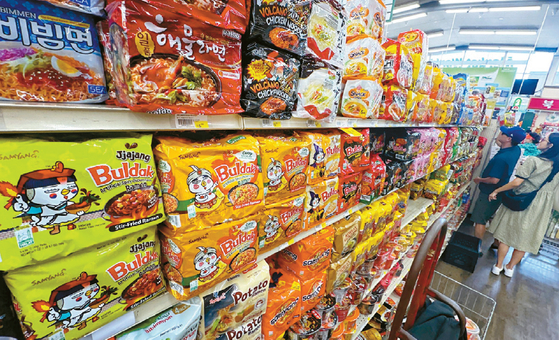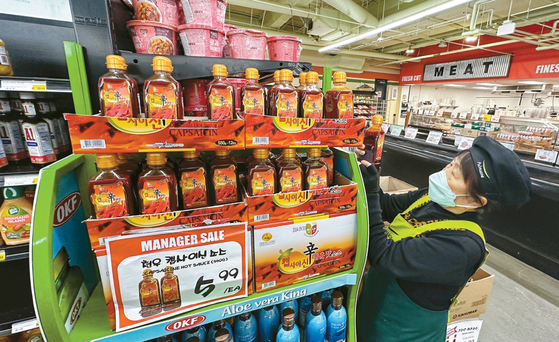
As K-food’s popularity soars, Korean groceries in the United States are sizzling with increasing sales of spicy ramen and hot sauces.
Despite a slowdown in consumer spending due to inflationary pressure, industry data show a steady uptick in spicy product sales.
“Post-pandemic, sales of spicy ramen surged, contributing to 20-25% of all ramen sales,” shared an industry insider. “The ‘spicy challenge’ cultural phenomenon, especially among Generation Z, has amplified this trend, suggesting people find relief from stress through spicy delights.”
Highly sought-after spicy products in Korean groceries in the United States predominantly include ramen and hot sauces.
The spicy ramen wave, spearheaded by Nongshim Shin Ramen, Ottogi Yeul Ramen, and Paldo Teumsae Ramen, gained further momentum with the 2012 debut of Samyang Buldak Ramen. This newfound enthusiasm sparked an influx of recipes allowing for varied flavor combinations. Now, over 10 buldak noodle variants grace Korean market shelves, including cheese, jjajang, carbonara, and meat spaghetti variants.
As buldak noodles set consumers’ taste buds ablaze, the crave for even spicier ramen intensified. Many now incorporate ingredients like garlic, pepper, capsaicin, chili peppers, and sriracha to enhance the heat.
Recognizing this demand, Samyang Foods recently unveiled Map Tang, a fiery broth ramen, in Korea. Ottogi followed suit, launching Ma Yeul Ramen—an evolution of Yeul Ramen infused with enhanced spiciness from garlic and pepper. Nongshim responded with Shin Ramen The Red, a limited-edition offering boasting a Scoville heat level 2.2 times that of its original Shin Ramen.
“The soaring demand has prompted a slew of new spicy ramen introductions,” commented an industry expert, further highlighting that for Samyang Food, the Buldak brand constitutes over 80% of its international sales.
“New additions from Samyang Foods, like Flaming Chili Jjajang and Flaming Chili Jjampong, are gaining traction,” stated a manager from Zion Market Vermont. “Consumers are especially fond of the robust spiciness found in products such as Paldo Fire Jjampong, Surasang Korean Style Noodle w. Soup & Seasoned Red Pepper Sauce, Surasang Malatang Udon Noodles, Paldo Bibim Noodles Spicy, and Dongwon Spicy Kalguksu.”
The next frontier in this spicy duel are sauces. Over ten different sauce types are available in Korea, including Samyang Buldak Sauce, Chungwoo Korean Capsaicin Sauce, Paldo Teumsae Sauce, and Isulnara Capsaicin.
Superior to chili oil in heat, capsaicin sauces are a favorite for adding an intense kick to dishes like ramen, soft tofu, jjamppong, and steamed seafood.

With a mounting demand for spicier alternatives to gochujang, Zion Market Vermont has dedicated a section solely to hot sauces. H-Mart has followed the trend with a specialized hot sauce shelf.
Social media and YouTube are replete with hot sauce food videos, driving sales at Korean groceries. “These sauces are now preferred accompaniments for fried chicken, kimbap, dumplings, and even pizza,” remarked a market representative.
This spicy surge finds resonance in Korea’s export figures to the United States. From January to July, exports of kimchi and gochujang—spicy staples—witnessed significant growth. Gochujang and kimchi exports to the United States soared by 29.8% and 31.3% year-on-year, respectively.
Furthermore, according to aT LA, the overall value of ramen exports saw a boost, primarily driven by spicy ramen’s robust performance. For the said period, ramen exports touched $69.75 million, marking a 31% increase from $53.25 million during the same months in the previous year.
“In 2023’s first half, exports of spicy delicacies like spicy ramen, tteokbokki, kimchi, and gochujang have skyrocketed,” reported Minho Kim of aT LA. “K-dramas and YouTube have played pivotal roles in piquing the curiosity of diverse ethnic groups.”
BY EUNYOOUNG LEE [lee.eunyoung6@koreadaily.com]




